Australian Cyber Law and Hacking: Policy and Legislation Report
VerifiedAdded on 2022/11/09
|11
|3265
|402
Report
AI Summary
This report, prepared for the Australian ministry, provides an overview of cyber laws in Australia, with a specific focus on hacking. It details the incident of cryptojacking and analyzes the current cyber legislation, including the Cyber Crime Act 2001, and its effectiveness. The report examines state and territory laws, highlighting issues of harmony and collaboration. It also discusses the importance of cybercrime awareness among the public and the government's efforts to combat cyber threats, including the Cyber Safety Pasifika program. The report assesses the challenges posed by hacking, particularly in light of Australia's technological and economic strengths, and recommends changes to policies to make them more effective in preventing future cyber-attacks. It explores the role of international cooperation, such as the Budapest Convention, in addressing cybercrime and emphasizes the need for a strong legislative framework and public awareness to counter the threats posed by hacking.
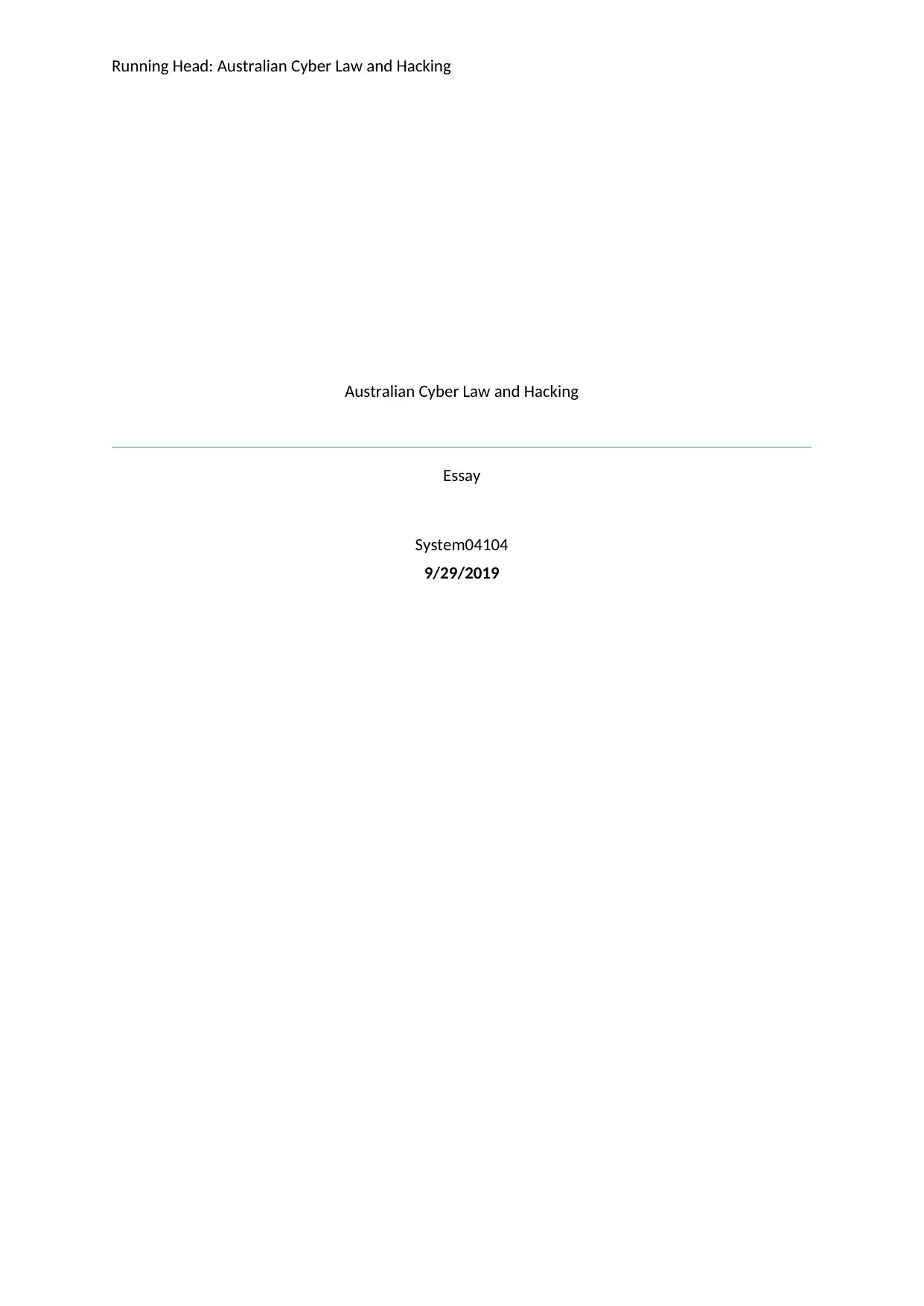
Running Head: Australian Cyber Law and Hacking
Australian Cyber Law and Hacking
Essay
System04104
9/29/2019
Australian Cyber Law and Hacking
Essay
System04104
9/29/2019
Paraphrase This Document
Need a fresh take? Get an instant paraphrase of this document with our AI Paraphraser
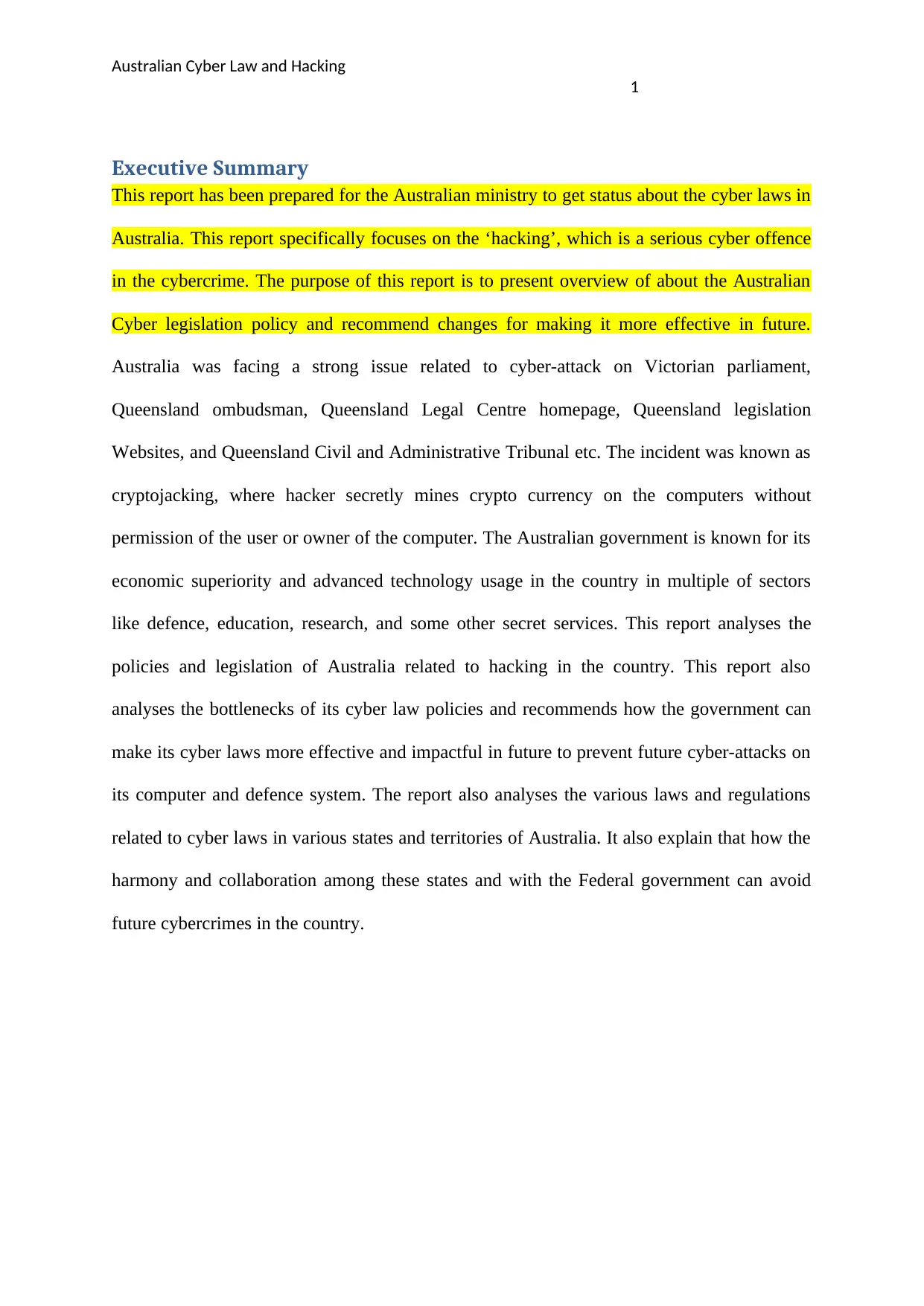
Australian Cyber Law and Hacking
1
Executive Summary
This report has been prepared for the Australian ministry to get status about the cyber laws in
Australia. This report specifically focuses on the ‘hacking’, which is a serious cyber offence
in the cybercrime. The purpose of this report is to present overview of about the Australian
Cyber legislation policy and recommend changes for making it more effective in future.
Australia was facing a strong issue related to cyber-attack on Victorian parliament,
Queensland ombudsman, Queensland Legal Centre homepage, Queensland legislation
Websites, and Queensland Civil and Administrative Tribunal etc. The incident was known as
cryptojacking, where hacker secretly mines crypto currency on the computers without
permission of the user or owner of the computer. The Australian government is known for its
economic superiority and advanced technology usage in the country in multiple of sectors
like defence, education, research, and some other secret services. This report analyses the
policies and legislation of Australia related to hacking in the country. This report also
analyses the bottlenecks of its cyber law policies and recommends how the government can
make its cyber laws more effective and impactful in future to prevent future cyber-attacks on
its computer and defence system. The report also analyses the various laws and regulations
related to cyber laws in various states and territories of Australia. It also explain that how the
harmony and collaboration among these states and with the Federal government can avoid
future cybercrimes in the country.
1
Executive Summary
This report has been prepared for the Australian ministry to get status about the cyber laws in
Australia. This report specifically focuses on the ‘hacking’, which is a serious cyber offence
in the cybercrime. The purpose of this report is to present overview of about the Australian
Cyber legislation policy and recommend changes for making it more effective in future.
Australia was facing a strong issue related to cyber-attack on Victorian parliament,
Queensland ombudsman, Queensland Legal Centre homepage, Queensland legislation
Websites, and Queensland Civil and Administrative Tribunal etc. The incident was known as
cryptojacking, where hacker secretly mines crypto currency on the computers without
permission of the user or owner of the computer. The Australian government is known for its
economic superiority and advanced technology usage in the country in multiple of sectors
like defence, education, research, and some other secret services. This report analyses the
policies and legislation of Australia related to hacking in the country. This report also
analyses the bottlenecks of its cyber law policies and recommends how the government can
make its cyber laws more effective and impactful in future to prevent future cyber-attacks on
its computer and defence system. The report also analyses the various laws and regulations
related to cyber laws in various states and territories of Australia. It also explain that how the
harmony and collaboration among these states and with the Federal government can avoid
future cybercrimes in the country.
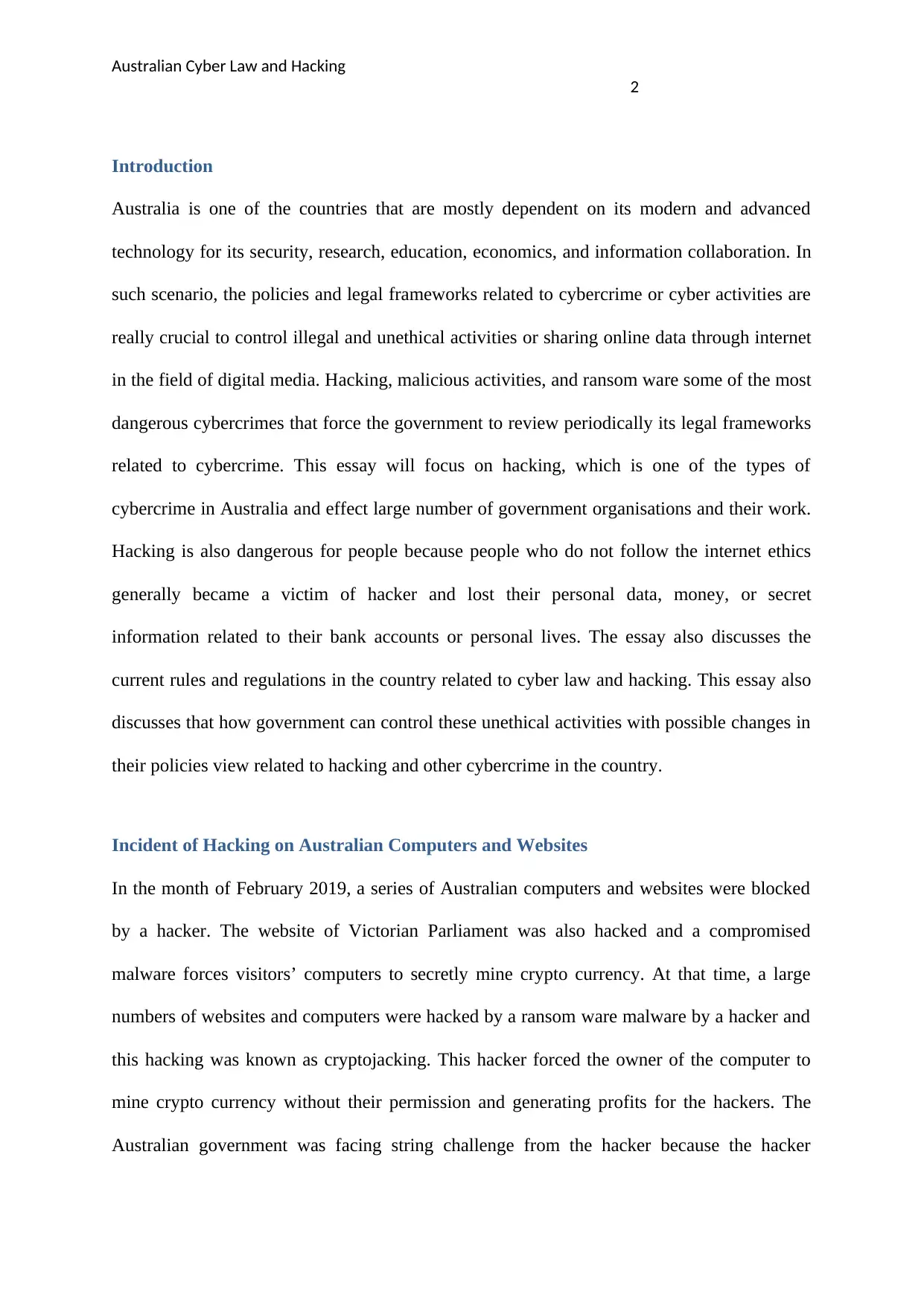
Australian Cyber Law and Hacking
2
Introduction
Australia is one of the countries that are mostly dependent on its modern and advanced
technology for its security, research, education, economics, and information collaboration. In
such scenario, the policies and legal frameworks related to cybercrime or cyber activities are
really crucial to control illegal and unethical activities or sharing online data through internet
in the field of digital media. Hacking, malicious activities, and ransom ware some of the most
dangerous cybercrimes that force the government to review periodically its legal frameworks
related to cybercrime. This essay will focus on hacking, which is one of the types of
cybercrime in Australia and effect large number of government organisations and their work.
Hacking is also dangerous for people because people who do not follow the internet ethics
generally became a victim of hacker and lost their personal data, money, or secret
information related to their bank accounts or personal lives. The essay also discusses the
current rules and regulations in the country related to cyber law and hacking. This essay also
discusses that how government can control these unethical activities with possible changes in
their policies view related to hacking and other cybercrime in the country.
Incident of Hacking on Australian Computers and Websites
In the month of February 2019, a series of Australian computers and websites were blocked
by a hacker. The website of Victorian Parliament was also hacked and a compromised
malware forces visitors’ computers to secretly mine crypto currency. At that time, a large
numbers of websites and computers were hacked by a ransom ware malware by a hacker and
this hacking was known as cryptojacking. This hacker forced the owner of the computer to
mine crypto currency without their permission and generating profits for the hackers. The
Australian government was facing string challenge from the hacker because the hacker
2
Introduction
Australia is one of the countries that are mostly dependent on its modern and advanced
technology for its security, research, education, economics, and information collaboration. In
such scenario, the policies and legal frameworks related to cybercrime or cyber activities are
really crucial to control illegal and unethical activities or sharing online data through internet
in the field of digital media. Hacking, malicious activities, and ransom ware some of the most
dangerous cybercrimes that force the government to review periodically its legal frameworks
related to cybercrime. This essay will focus on hacking, which is one of the types of
cybercrime in Australia and effect large number of government organisations and their work.
Hacking is also dangerous for people because people who do not follow the internet ethics
generally became a victim of hacker and lost their personal data, money, or secret
information related to their bank accounts or personal lives. The essay also discusses the
current rules and regulations in the country related to cyber law and hacking. This essay also
discusses that how government can control these unethical activities with possible changes in
their policies view related to hacking and other cybercrime in the country.
Incident of Hacking on Australian Computers and Websites
In the month of February 2019, a series of Australian computers and websites were blocked
by a hacker. The website of Victorian Parliament was also hacked and a compromised
malware forces visitors’ computers to secretly mine crypto currency. At that time, a large
numbers of websites and computers were hacked by a ransom ware malware by a hacker and
this hacking was known as cryptojacking. This hacker forced the owner of the computer to
mine crypto currency without their permission and generating profits for the hackers. The
Australian government was facing string challenge from the hacker because the hacker
⊘ This is a preview!⊘
Do you want full access?
Subscribe today to unlock all pages.

Trusted by 1+ million students worldwide
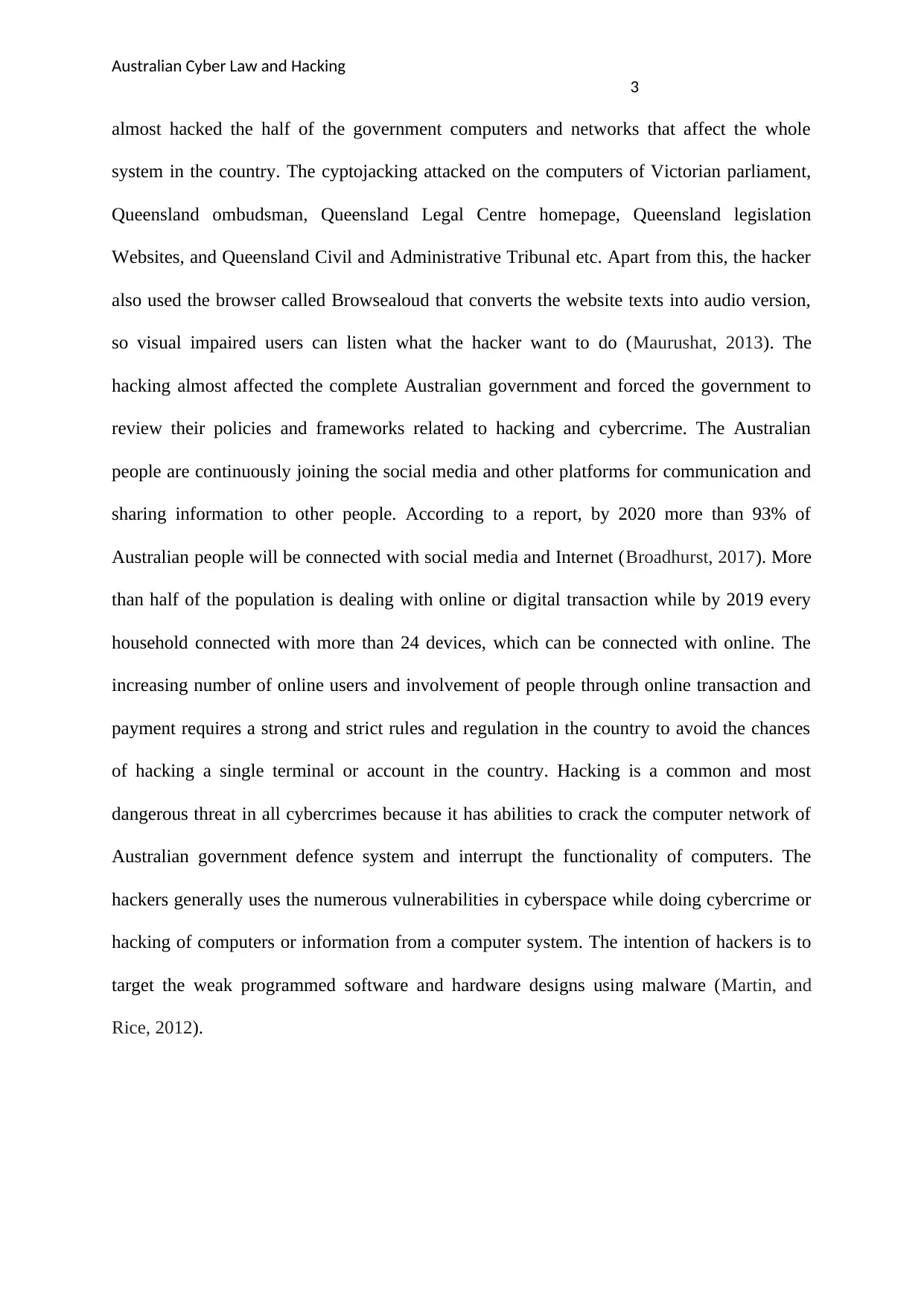
Australian Cyber Law and Hacking
3
almost hacked the half of the government computers and networks that affect the whole
system in the country. The cyptojacking attacked on the computers of Victorian parliament,
Queensland ombudsman, Queensland Legal Centre homepage, Queensland legislation
Websites, and Queensland Civil and Administrative Tribunal etc. Apart from this, the hacker
also used the browser called Browsealoud that converts the website texts into audio version,
so visual impaired users can listen what the hacker want to do (Maurushat, 2013). The
hacking almost affected the complete Australian government and forced the government to
review their policies and frameworks related to hacking and cybercrime. The Australian
people are continuously joining the social media and other platforms for communication and
sharing information to other people. According to a report, by 2020 more than 93% of
Australian people will be connected with social media and Internet (Broadhurst, 2017). More
than half of the population is dealing with online or digital transaction while by 2019 every
household connected with more than 24 devices, which can be connected with online. The
increasing number of online users and involvement of people through online transaction and
payment requires a strong and strict rules and regulation in the country to avoid the chances
of hacking a single terminal or account in the country. Hacking is a common and most
dangerous threat in all cybercrimes because it has abilities to crack the computer network of
Australian government defence system and interrupt the functionality of computers. The
hackers generally uses the numerous vulnerabilities in cyberspace while doing cybercrime or
hacking of computers or information from a computer system. The intention of hackers is to
target the weak programmed software and hardware designs using malware (Martin, and
Rice, 2012).
3
almost hacked the half of the government computers and networks that affect the whole
system in the country. The cyptojacking attacked on the computers of Victorian parliament,
Queensland ombudsman, Queensland Legal Centre homepage, Queensland legislation
Websites, and Queensland Civil and Administrative Tribunal etc. Apart from this, the hacker
also used the browser called Browsealoud that converts the website texts into audio version,
so visual impaired users can listen what the hacker want to do (Maurushat, 2013). The
hacking almost affected the complete Australian government and forced the government to
review their policies and frameworks related to hacking and cybercrime. The Australian
people are continuously joining the social media and other platforms for communication and
sharing information to other people. According to a report, by 2020 more than 93% of
Australian people will be connected with social media and Internet (Broadhurst, 2017). More
than half of the population is dealing with online or digital transaction while by 2019 every
household connected with more than 24 devices, which can be connected with online. The
increasing number of online users and involvement of people through online transaction and
payment requires a strong and strict rules and regulation in the country to avoid the chances
of hacking a single terminal or account in the country. Hacking is a common and most
dangerous threat in all cybercrimes because it has abilities to crack the computer network of
Australian government defence system and interrupt the functionality of computers. The
hackers generally uses the numerous vulnerabilities in cyberspace while doing cybercrime or
hacking of computers or information from a computer system. The intention of hackers is to
target the weak programmed software and hardware designs using malware (Martin, and
Rice, 2012).
Paraphrase This Document
Need a fresh take? Get an instant paraphrase of this document with our AI Paraphraser
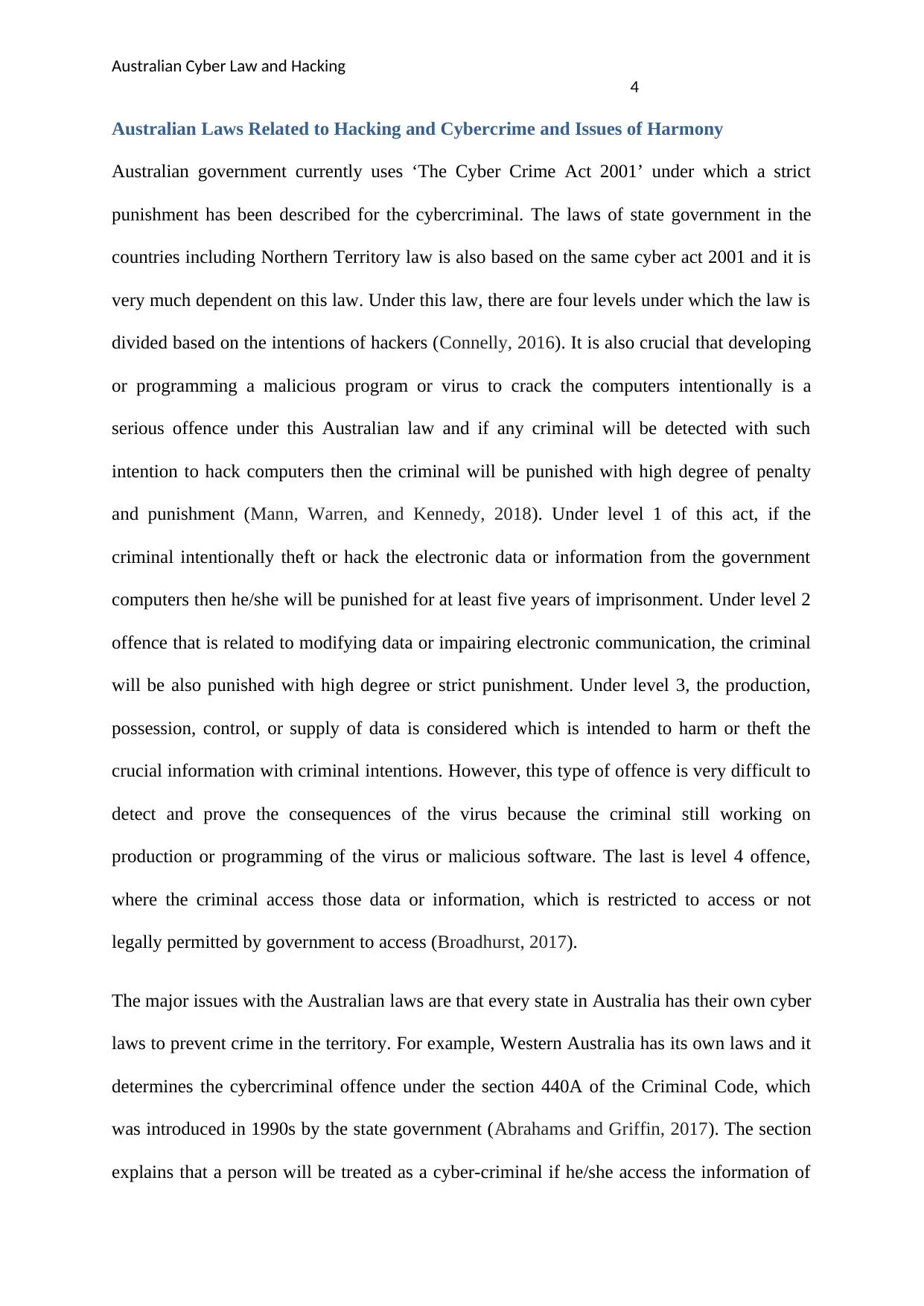
Australian Cyber Law and Hacking
4
Australian Laws Related to Hacking and Cybercrime and Issues of Harmony
Australian government currently uses ‘The Cyber Crime Act 2001’ under which a strict
punishment has been described for the cybercriminal. The laws of state government in the
countries including Northern Territory law is also based on the same cyber act 2001 and it is
very much dependent on this law. Under this law, there are four levels under which the law is
divided based on the intentions of hackers (Connelly, 2016). It is also crucial that developing
or programming a malicious program or virus to crack the computers intentionally is a
serious offence under this Australian law and if any criminal will be detected with such
intention to hack computers then the criminal will be punished with high degree of penalty
and punishment (Mann, Warren, and Kennedy, 2018). Under level 1 of this act, if the
criminal intentionally theft or hack the electronic data or information from the government
computers then he/she will be punished for at least five years of imprisonment. Under level 2
offence that is related to modifying data or impairing electronic communication, the criminal
will be also punished with high degree or strict punishment. Under level 3, the production,
possession, control, or supply of data is considered which is intended to harm or theft the
crucial information with criminal intentions. However, this type of offence is very difficult to
detect and prove the consequences of the virus because the criminal still working on
production or programming of the virus or malicious software. The last is level 4 offence,
where the criminal access those data or information, which is restricted to access or not
legally permitted by government to access (Broadhurst, 2017).
The major issues with the Australian laws are that every state in Australia has their own cyber
laws to prevent crime in the territory. For example, Western Australia has its own laws and it
determines the cybercriminal offence under the section 440A of the Criminal Code, which
was introduced in 1990s by the state government (Abrahams and Griffin, 2017). The section
explains that a person will be treated as a cyber-criminal if he/she access the information of
4
Australian Laws Related to Hacking and Cybercrime and Issues of Harmony
Australian government currently uses ‘The Cyber Crime Act 2001’ under which a strict
punishment has been described for the cybercriminal. The laws of state government in the
countries including Northern Territory law is also based on the same cyber act 2001 and it is
very much dependent on this law. Under this law, there are four levels under which the law is
divided based on the intentions of hackers (Connelly, 2016). It is also crucial that developing
or programming a malicious program or virus to crack the computers intentionally is a
serious offence under this Australian law and if any criminal will be detected with such
intention to hack computers then the criminal will be punished with high degree of penalty
and punishment (Mann, Warren, and Kennedy, 2018). Under level 1 of this act, if the
criminal intentionally theft or hack the electronic data or information from the government
computers then he/she will be punished for at least five years of imprisonment. Under level 2
offence that is related to modifying data or impairing electronic communication, the criminal
will be also punished with high degree or strict punishment. Under level 3, the production,
possession, control, or supply of data is considered which is intended to harm or theft the
crucial information with criminal intentions. However, this type of offence is very difficult to
detect and prove the consequences of the virus because the criminal still working on
production or programming of the virus or malicious software. The last is level 4 offence,
where the criminal access those data or information, which is restricted to access or not
legally permitted by government to access (Broadhurst, 2017).
The major issues with the Australian laws are that every state in Australia has their own cyber
laws to prevent crime in the territory. For example, Western Australia has its own laws and it
determines the cybercriminal offence under the section 440A of the Criminal Code, which
was introduced in 1990s by the state government (Abrahams and Griffin, 2017). The section
explains that a person will be treated as a cyber-criminal if he/she access the information of
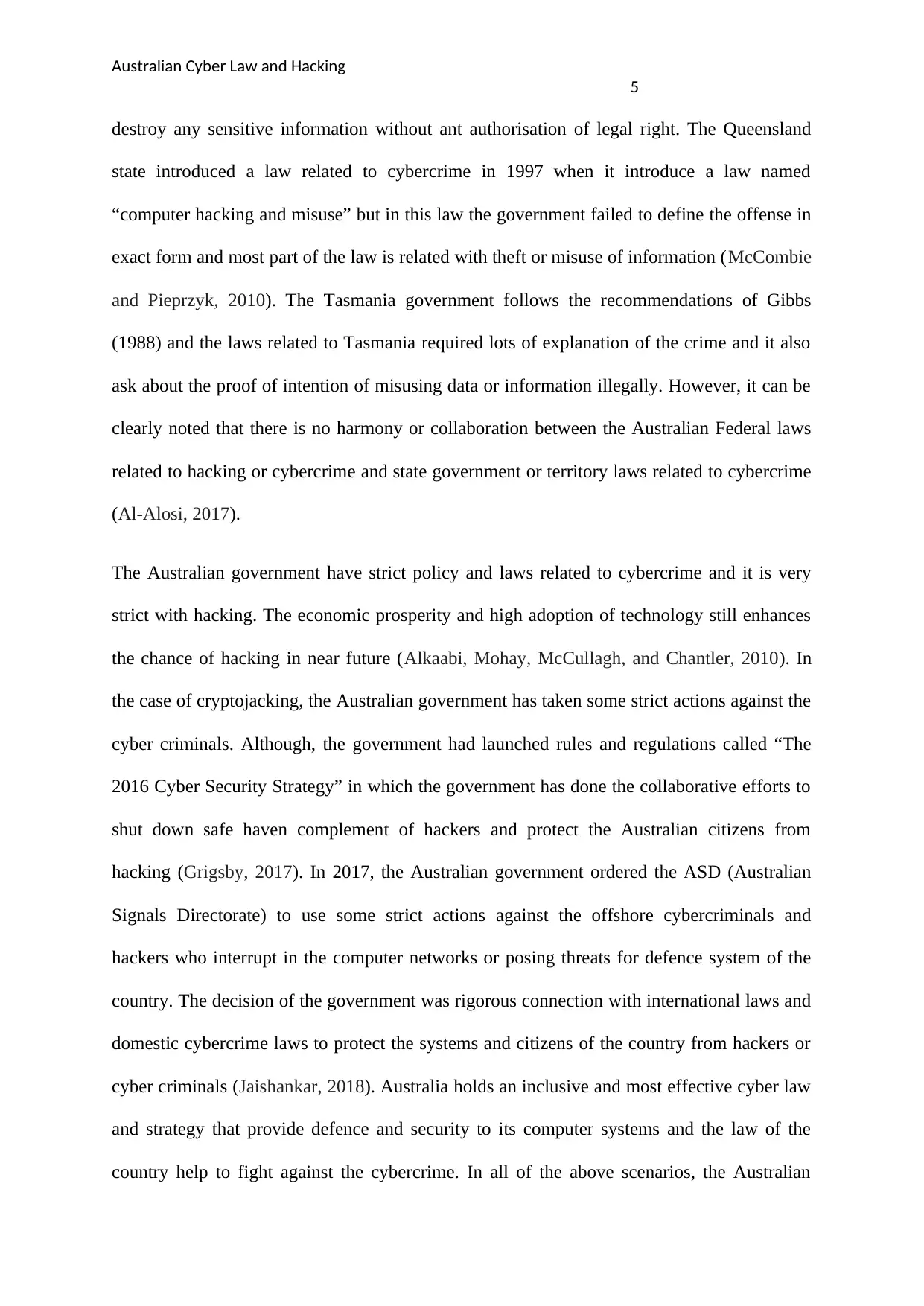
Australian Cyber Law and Hacking
5
destroy any sensitive information without ant authorisation of legal right. The Queensland
state introduced a law related to cybercrime in 1997 when it introduce a law named
“computer hacking and misuse” but in this law the government failed to define the offense in
exact form and most part of the law is related with theft or misuse of information (McCombie
and Pieprzyk, 2010). The Tasmania government follows the recommendations of Gibbs
(1988) and the laws related to Tasmania required lots of explanation of the crime and it also
ask about the proof of intention of misusing data or information illegally. However, it can be
clearly noted that there is no harmony or collaboration between the Australian Federal laws
related to hacking or cybercrime and state government or territory laws related to cybercrime
(Al-Alosi, 2017).
The Australian government have strict policy and laws related to cybercrime and it is very
strict with hacking. The economic prosperity and high adoption of technology still enhances
the chance of hacking in near future (Alkaabi, Mohay, McCullagh, and Chantler, 2010). In
the case of cryptojacking, the Australian government has taken some strict actions against the
cyber criminals. Although, the government had launched rules and regulations called “The
2016 Cyber Security Strategy” in which the government has done the collaborative efforts to
shut down safe haven complement of hackers and protect the Australian citizens from
hacking (Grigsby, 2017). In 2017, the Australian government ordered the ASD (Australian
Signals Directorate) to use some strict actions against the offshore cybercriminals and
hackers who interrupt in the computer networks or posing threats for defence system of the
country. The decision of the government was rigorous connection with international laws and
domestic cybercrime laws to protect the systems and citizens of the country from hackers or
cyber criminals (Jaishankar, 2018). Australia holds an inclusive and most effective cyber law
and strategy that provide defence and security to its computer systems and the law of the
country help to fight against the cybercrime. In all of the above scenarios, the Australian
5
destroy any sensitive information without ant authorisation of legal right. The Queensland
state introduced a law related to cybercrime in 1997 when it introduce a law named
“computer hacking and misuse” but in this law the government failed to define the offense in
exact form and most part of the law is related with theft or misuse of information (McCombie
and Pieprzyk, 2010). The Tasmania government follows the recommendations of Gibbs
(1988) and the laws related to Tasmania required lots of explanation of the crime and it also
ask about the proof of intention of misusing data or information illegally. However, it can be
clearly noted that there is no harmony or collaboration between the Australian Federal laws
related to hacking or cybercrime and state government or territory laws related to cybercrime
(Al-Alosi, 2017).
The Australian government have strict policy and laws related to cybercrime and it is very
strict with hacking. The economic prosperity and high adoption of technology still enhances
the chance of hacking in near future (Alkaabi, Mohay, McCullagh, and Chantler, 2010). In
the case of cryptojacking, the Australian government has taken some strict actions against the
cyber criminals. Although, the government had launched rules and regulations called “The
2016 Cyber Security Strategy” in which the government has done the collaborative efforts to
shut down safe haven complement of hackers and protect the Australian citizens from
hacking (Grigsby, 2017). In 2017, the Australian government ordered the ASD (Australian
Signals Directorate) to use some strict actions against the offshore cybercriminals and
hackers who interrupt in the computer networks or posing threats for defence system of the
country. The decision of the government was rigorous connection with international laws and
domestic cybercrime laws to protect the systems and citizens of the country from hackers or
cyber criminals (Jaishankar, 2018). Australia holds an inclusive and most effective cyber law
and strategy that provide defence and security to its computer systems and the law of the
country help to fight against the cybercrime. In all of the above scenarios, the Australian
⊘ This is a preview!⊘
Do you want full access?
Subscribe today to unlock all pages.

Trusted by 1+ million students worldwide
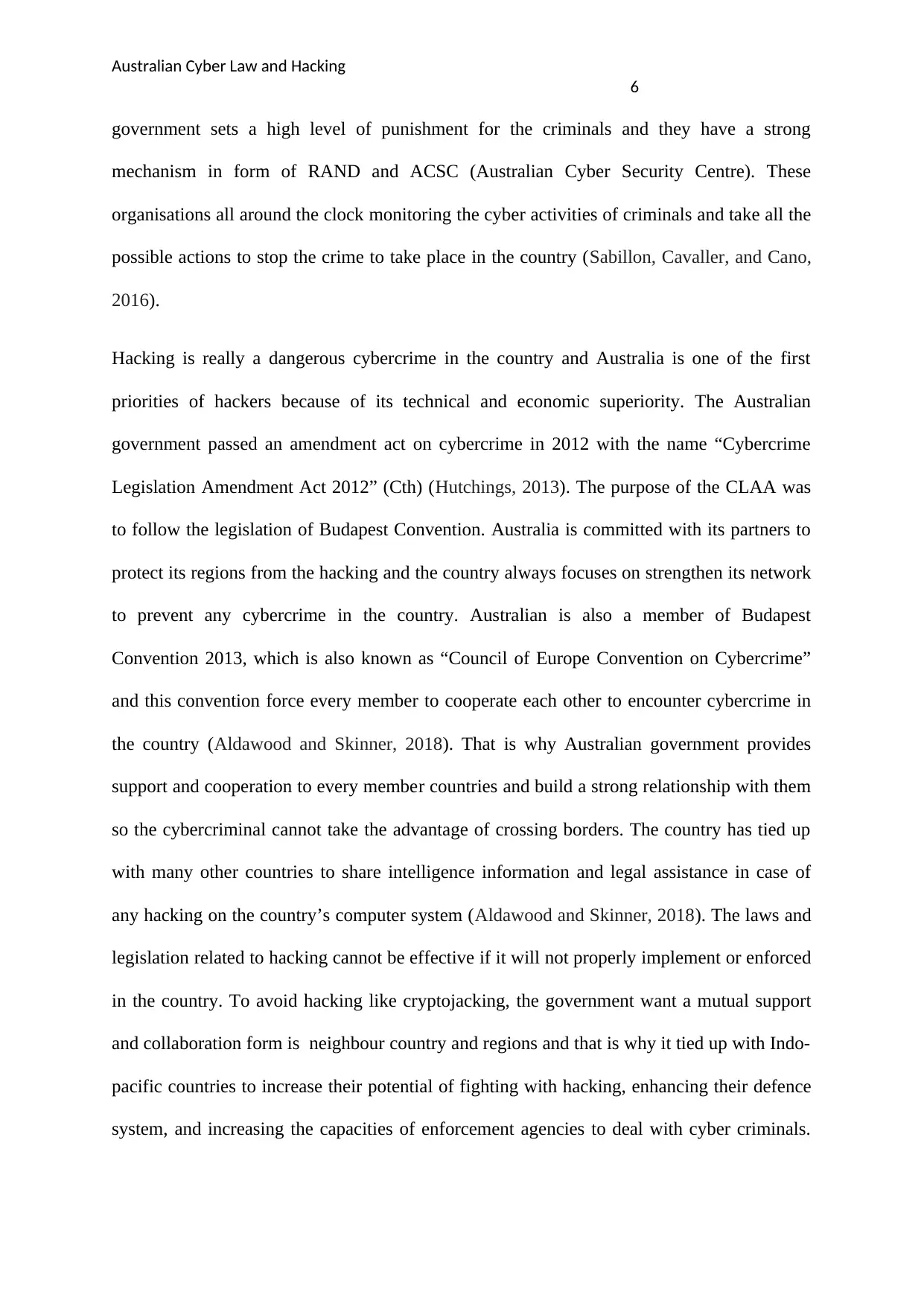
Australian Cyber Law and Hacking
6
government sets a high level of punishment for the criminals and they have a strong
mechanism in form of RAND and ACSC (Australian Cyber Security Centre). These
organisations all around the clock monitoring the cyber activities of criminals and take all the
possible actions to stop the crime to take place in the country (Sabillon, Cavaller, and Cano,
2016).
Hacking is really a dangerous cybercrime in the country and Australia is one of the first
priorities of hackers because of its technical and economic superiority. The Australian
government passed an amendment act on cybercrime in 2012 with the name “Cybercrime
Legislation Amendment Act 2012” (Cth) (Hutchings, 2013). The purpose of the CLAA was
to follow the legislation of Budapest Convention. Australia is committed with its partners to
protect its regions from the hacking and the country always focuses on strengthen its network
to prevent any cybercrime in the country. Australian is also a member of Budapest
Convention 2013, which is also known as “Council of Europe Convention on Cybercrime”
and this convention force every member to cooperate each other to encounter cybercrime in
the country (Aldawood and Skinner, 2018). That is why Australian government provides
support and cooperation to every member countries and build a strong relationship with them
so the cybercriminal cannot take the advantage of crossing borders. The country has tied up
with many other countries to share intelligence information and legal assistance in case of
any hacking on the country’s computer system (Aldawood and Skinner, 2018). The laws and
legislation related to hacking cannot be effective if it will not properly implement or enforced
in the country. To avoid hacking like cryptojacking, the government want a mutual support
and collaboration form is neighbour country and regions and that is why it tied up with Indo-
pacific countries to increase their potential of fighting with hacking, enhancing their defence
system, and increasing the capacities of enforcement agencies to deal with cyber criminals.
6
government sets a high level of punishment for the criminals and they have a strong
mechanism in form of RAND and ACSC (Australian Cyber Security Centre). These
organisations all around the clock monitoring the cyber activities of criminals and take all the
possible actions to stop the crime to take place in the country (Sabillon, Cavaller, and Cano,
2016).
Hacking is really a dangerous cybercrime in the country and Australia is one of the first
priorities of hackers because of its technical and economic superiority. The Australian
government passed an amendment act on cybercrime in 2012 with the name “Cybercrime
Legislation Amendment Act 2012” (Cth) (Hutchings, 2013). The purpose of the CLAA was
to follow the legislation of Budapest Convention. Australia is committed with its partners to
protect its regions from the hacking and the country always focuses on strengthen its network
to prevent any cybercrime in the country. Australian is also a member of Budapest
Convention 2013, which is also known as “Council of Europe Convention on Cybercrime”
and this convention force every member to cooperate each other to encounter cybercrime in
the country (Aldawood and Skinner, 2018). That is why Australian government provides
support and cooperation to every member countries and build a strong relationship with them
so the cybercriminal cannot take the advantage of crossing borders. The country has tied up
with many other countries to share intelligence information and legal assistance in case of
any hacking on the country’s computer system (Aldawood and Skinner, 2018). The laws and
legislation related to hacking cannot be effective if it will not properly implement or enforced
in the country. To avoid hacking like cryptojacking, the government want a mutual support
and collaboration form is neighbour country and regions and that is why it tied up with Indo-
pacific countries to increase their potential of fighting with hacking, enhancing their defence
system, and increasing the capacities of enforcement agencies to deal with cyber criminals.
Paraphrase This Document
Need a fresh take? Get an instant paraphrase of this document with our AI Paraphraser
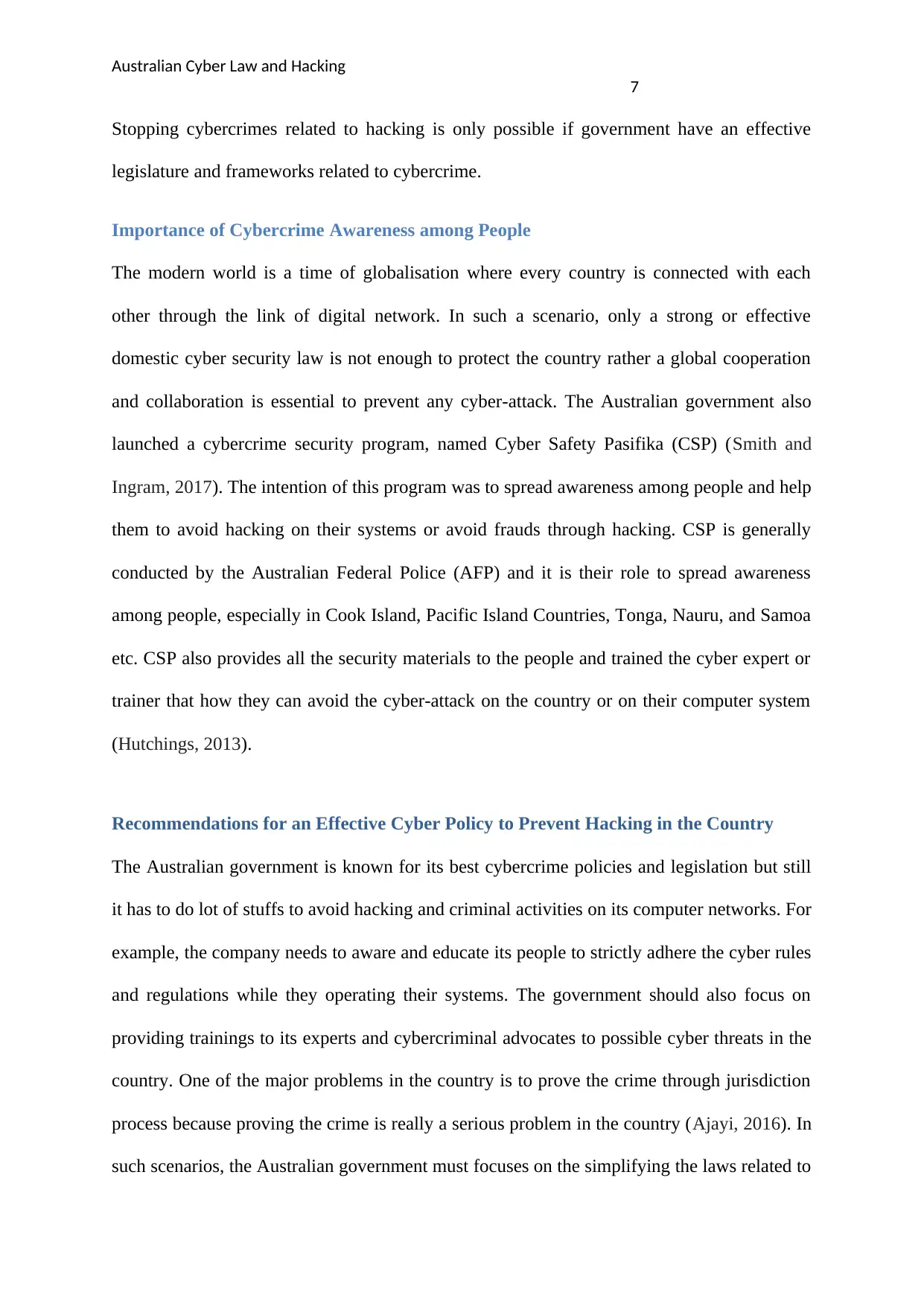
Australian Cyber Law and Hacking
7
Stopping cybercrimes related to hacking is only possible if government have an effective
legislature and frameworks related to cybercrime.
Importance of Cybercrime Awareness among People
The modern world is a time of globalisation where every country is connected with each
other through the link of digital network. In such a scenario, only a strong or effective
domestic cyber security law is not enough to protect the country rather a global cooperation
and collaboration is essential to prevent any cyber-attack. The Australian government also
launched a cybercrime security program, named Cyber Safety Pasifika (CSP) (Smith and
Ingram, 2017). The intention of this program was to spread awareness among people and help
them to avoid hacking on their systems or avoid frauds through hacking. CSP is generally
conducted by the Australian Federal Police (AFP) and it is their role to spread awareness
among people, especially in Cook Island, Pacific Island Countries, Tonga, Nauru, and Samoa
etc. CSP also provides all the security materials to the people and trained the cyber expert or
trainer that how they can avoid the cyber-attack on the country or on their computer system
(Hutchings, 2013).
Recommendations for an Effective Cyber Policy to Prevent Hacking in the Country
The Australian government is known for its best cybercrime policies and legislation but still
it has to do lot of stuffs to avoid hacking and criminal activities on its computer networks. For
example, the company needs to aware and educate its people to strictly adhere the cyber rules
and regulations while they operating their systems. The government should also focus on
providing trainings to its experts and cybercriminal advocates to possible cyber threats in the
country. One of the major problems in the country is to prove the crime through jurisdiction
process because proving the crime is really a serious problem in the country (Ajayi, 2016). In
such scenarios, the Australian government must focuses on the simplifying the laws related to
7
Stopping cybercrimes related to hacking is only possible if government have an effective
legislature and frameworks related to cybercrime.
Importance of Cybercrime Awareness among People
The modern world is a time of globalisation where every country is connected with each
other through the link of digital network. In such a scenario, only a strong or effective
domestic cyber security law is not enough to protect the country rather a global cooperation
and collaboration is essential to prevent any cyber-attack. The Australian government also
launched a cybercrime security program, named Cyber Safety Pasifika (CSP) (Smith and
Ingram, 2017). The intention of this program was to spread awareness among people and help
them to avoid hacking on their systems or avoid frauds through hacking. CSP is generally
conducted by the Australian Federal Police (AFP) and it is their role to spread awareness
among people, especially in Cook Island, Pacific Island Countries, Tonga, Nauru, and Samoa
etc. CSP also provides all the security materials to the people and trained the cyber expert or
trainer that how they can avoid the cyber-attack on the country or on their computer system
(Hutchings, 2013).
Recommendations for an Effective Cyber Policy to Prevent Hacking in the Country
The Australian government is known for its best cybercrime policies and legislation but still
it has to do lot of stuffs to avoid hacking and criminal activities on its computer networks. For
example, the company needs to aware and educate its people to strictly adhere the cyber rules
and regulations while they operating their systems. The government should also focus on
providing trainings to its experts and cybercriminal advocates to possible cyber threats in the
country. One of the major problems in the country is to prove the crime through jurisdiction
process because proving the crime is really a serious problem in the country (Ajayi, 2016). In
such scenarios, the Australian government must focuses on the simplifying the laws related to
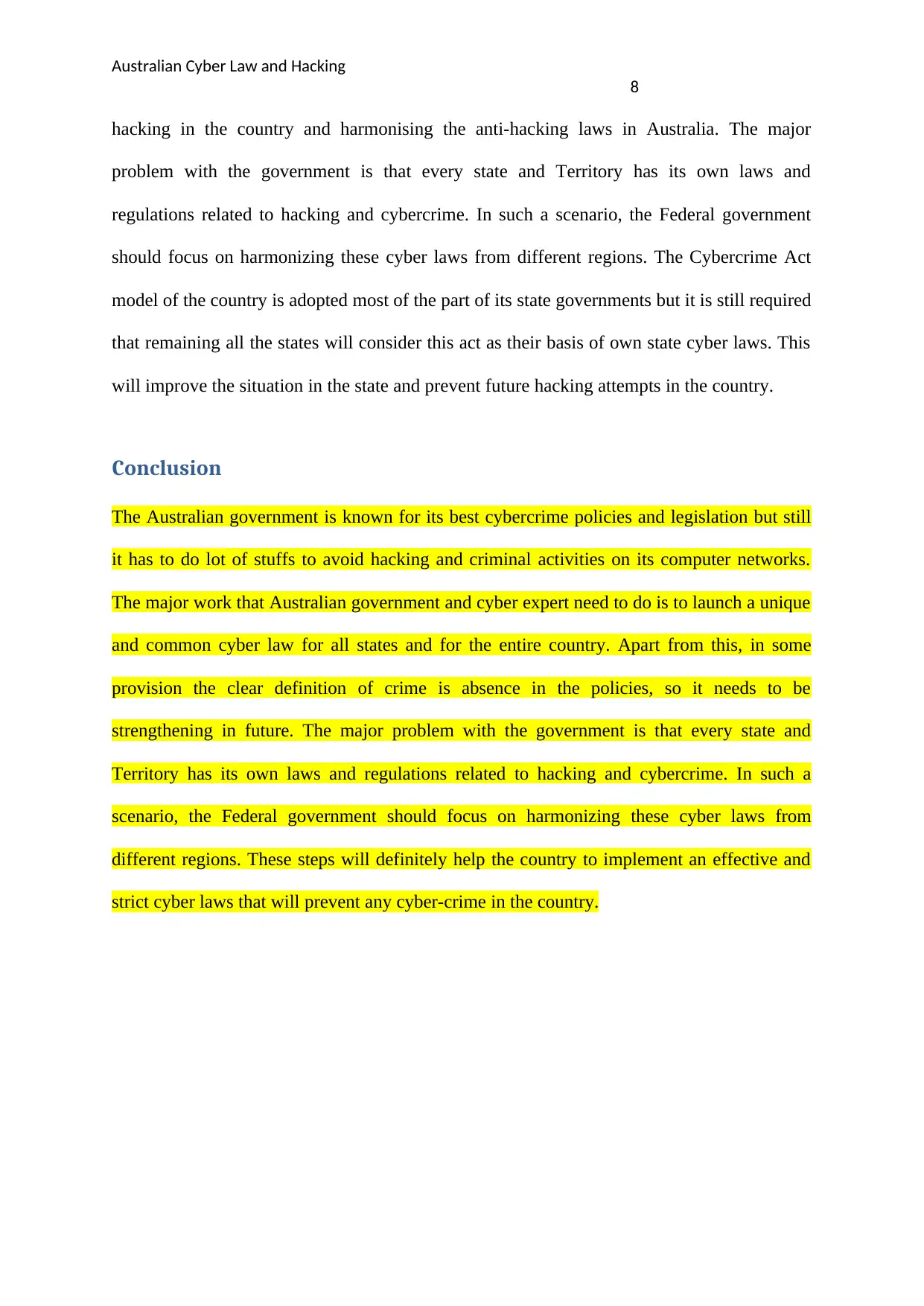
Australian Cyber Law and Hacking
8
hacking in the country and harmonising the anti-hacking laws in Australia. The major
problem with the government is that every state and Territory has its own laws and
regulations related to hacking and cybercrime. In such a scenario, the Federal government
should focus on harmonizing these cyber laws from different regions. The Cybercrime Act
model of the country is adopted most of the part of its state governments but it is still required
that remaining all the states will consider this act as their basis of own state cyber laws. This
will improve the situation in the state and prevent future hacking attempts in the country.
Conclusion
The Australian government is known for its best cybercrime policies and legislation but still
it has to do lot of stuffs to avoid hacking and criminal activities on its computer networks.
The major work that Australian government and cyber expert need to do is to launch a unique
and common cyber law for all states and for the entire country. Apart from this, in some
provision the clear definition of crime is absence in the policies, so it needs to be
strengthening in future. The major problem with the government is that every state and
Territory has its own laws and regulations related to hacking and cybercrime. In such a
scenario, the Federal government should focus on harmonizing these cyber laws from
different regions. These steps will definitely help the country to implement an effective and
strict cyber laws that will prevent any cyber-crime in the country.
8
hacking in the country and harmonising the anti-hacking laws in Australia. The major
problem with the government is that every state and Territory has its own laws and
regulations related to hacking and cybercrime. In such a scenario, the Federal government
should focus on harmonizing these cyber laws from different regions. The Cybercrime Act
model of the country is adopted most of the part of its state governments but it is still required
that remaining all the states will consider this act as their basis of own state cyber laws. This
will improve the situation in the state and prevent future hacking attempts in the country.
Conclusion
The Australian government is known for its best cybercrime policies and legislation but still
it has to do lot of stuffs to avoid hacking and criminal activities on its computer networks.
The major work that Australian government and cyber expert need to do is to launch a unique
and common cyber law for all states and for the entire country. Apart from this, in some
provision the clear definition of crime is absence in the policies, so it needs to be
strengthening in future. The major problem with the government is that every state and
Territory has its own laws and regulations related to hacking and cybercrime. In such a
scenario, the Federal government should focus on harmonizing these cyber laws from
different regions. These steps will definitely help the country to implement an effective and
strict cyber laws that will prevent any cyber-crime in the country.
⊘ This is a preview!⊘
Do you want full access?
Subscribe today to unlock all pages.

Trusted by 1+ million students worldwide
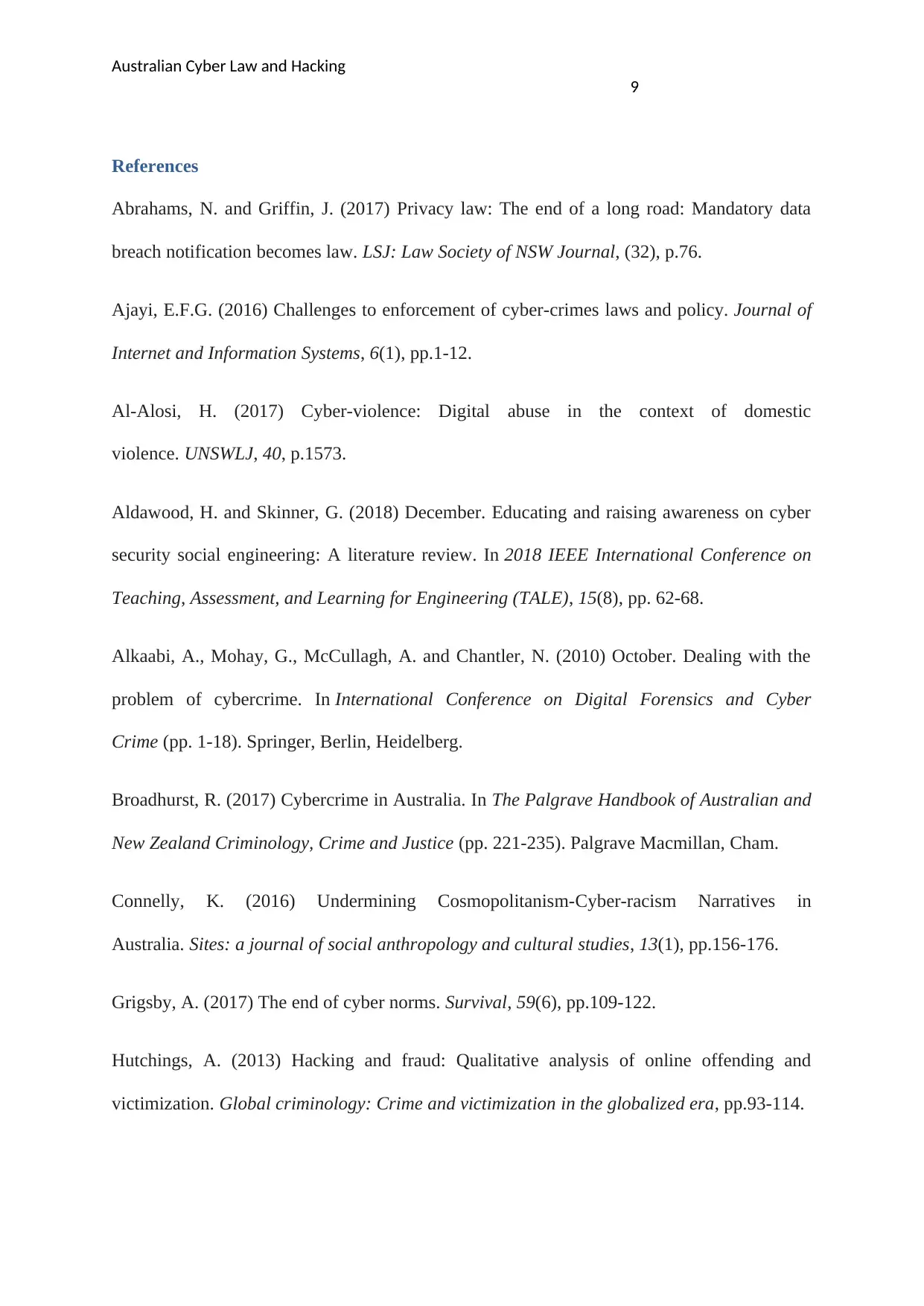
Australian Cyber Law and Hacking
9
References
Abrahams, N. and Griffin, J. (2017) Privacy law: The end of a long road: Mandatory data
breach notification becomes law. LSJ: Law Society of NSW Journal, (32), p.76.
Ajayi, E.F.G. (2016) Challenges to enforcement of cyber-crimes laws and policy. Journal of
Internet and Information Systems, 6(1), pp.1-12.
Al-Alosi, H. (2017) Cyber-violence: Digital abuse in the context of domestic
violence. UNSWLJ, 40, p.1573.
Aldawood, H. and Skinner, G. (2018) December. Educating and raising awareness on cyber
security social engineering: A literature review. In 2018 IEEE International Conference on
Teaching, Assessment, and Learning for Engineering (TALE), 15(8), pp. 62-68.
Alkaabi, A., Mohay, G., McCullagh, A. and Chantler, N. (2010) October. Dealing with the
problem of cybercrime. In International Conference on Digital Forensics and Cyber
Crime (pp. 1-18). Springer, Berlin, Heidelberg.
Broadhurst, R. (2017) Cybercrime in Australia. In The Palgrave Handbook of Australian and
New Zealand Criminology, Crime and Justice (pp. 221-235). Palgrave Macmillan, Cham.
Connelly, K. (2016) Undermining Cosmopolitanism-Cyber-racism Narratives in
Australia. Sites: a journal of social anthropology and cultural studies, 13(1), pp.156-176.
Grigsby, A. (2017) The end of cyber norms. Survival, 59(6), pp.109-122.
Hutchings, A. (2013) Hacking and fraud: Qualitative analysis of online offending and
victimization. Global criminology: Crime and victimization in the globalized era, pp.93-114.
9
References
Abrahams, N. and Griffin, J. (2017) Privacy law: The end of a long road: Mandatory data
breach notification becomes law. LSJ: Law Society of NSW Journal, (32), p.76.
Ajayi, E.F.G. (2016) Challenges to enforcement of cyber-crimes laws and policy. Journal of
Internet and Information Systems, 6(1), pp.1-12.
Al-Alosi, H. (2017) Cyber-violence: Digital abuse in the context of domestic
violence. UNSWLJ, 40, p.1573.
Aldawood, H. and Skinner, G. (2018) December. Educating and raising awareness on cyber
security social engineering: A literature review. In 2018 IEEE International Conference on
Teaching, Assessment, and Learning for Engineering (TALE), 15(8), pp. 62-68.
Alkaabi, A., Mohay, G., McCullagh, A. and Chantler, N. (2010) October. Dealing with the
problem of cybercrime. In International Conference on Digital Forensics and Cyber
Crime (pp. 1-18). Springer, Berlin, Heidelberg.
Broadhurst, R. (2017) Cybercrime in Australia. In The Palgrave Handbook of Australian and
New Zealand Criminology, Crime and Justice (pp. 221-235). Palgrave Macmillan, Cham.
Connelly, K. (2016) Undermining Cosmopolitanism-Cyber-racism Narratives in
Australia. Sites: a journal of social anthropology and cultural studies, 13(1), pp.156-176.
Grigsby, A. (2017) The end of cyber norms. Survival, 59(6), pp.109-122.
Hutchings, A. (2013) Hacking and fraud: Qualitative analysis of online offending and
victimization. Global criminology: Crime and victimization in the globalized era, pp.93-114.
Paraphrase This Document
Need a fresh take? Get an instant paraphrase of this document with our AI Paraphraser
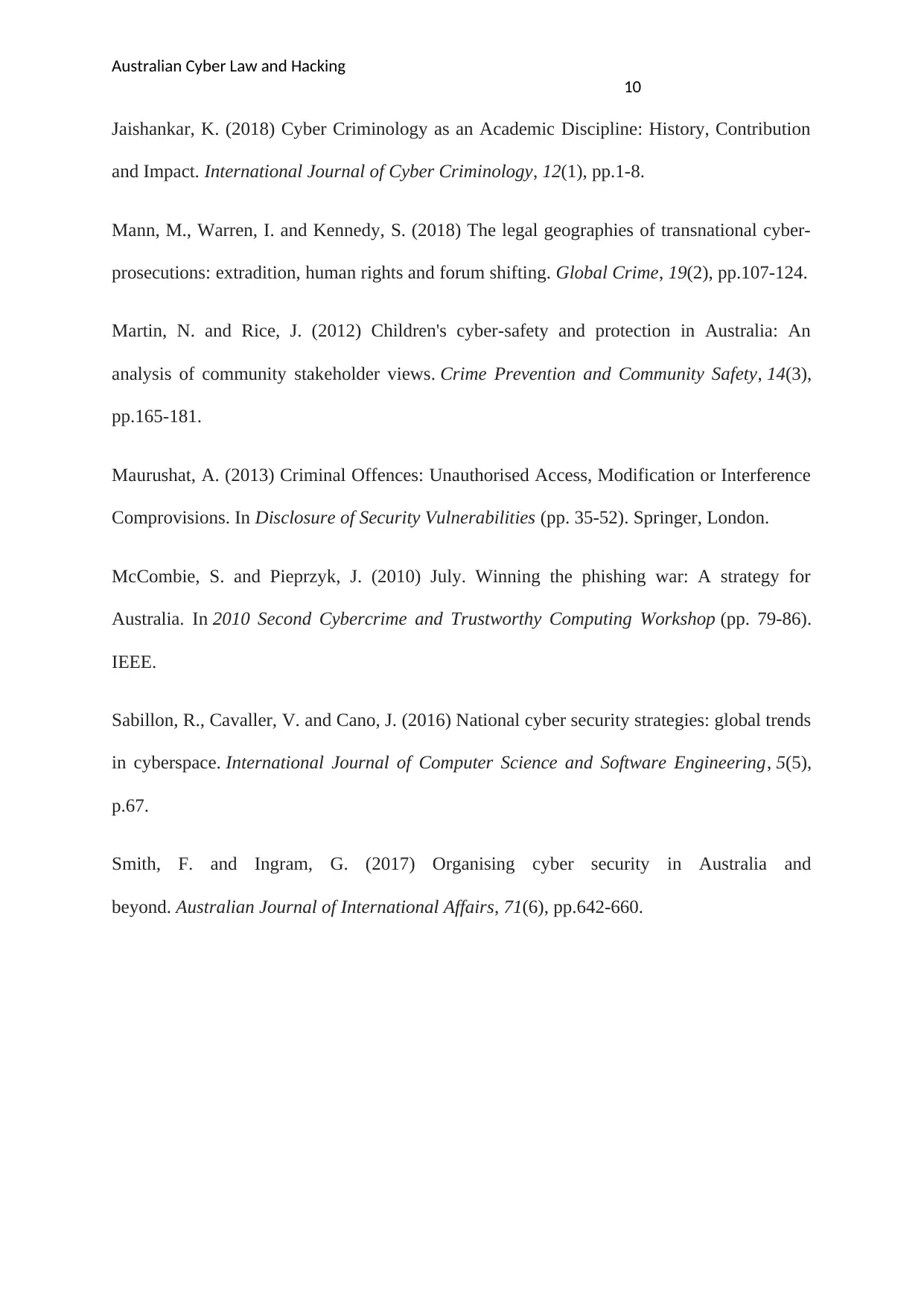
Australian Cyber Law and Hacking
10
Jaishankar, K. (2018) Cyber Criminology as an Academic Discipline: History, Contribution
and Impact. International Journal of Cyber Criminology, 12(1), pp.1-8.
Mann, M., Warren, I. and Kennedy, S. (2018) The legal geographies of transnational cyber-
prosecutions: extradition, human rights and forum shifting. Global Crime, 19(2), pp.107-124.
Martin, N. and Rice, J. (2012) Children's cyber-safety and protection in Australia: An
analysis of community stakeholder views. Crime Prevention and Community Safety, 14(3),
pp.165-181.
Maurushat, A. (2013) Criminal Offences: Unauthorised Access, Modification or Interference
Comprovisions. In Disclosure of Security Vulnerabilities (pp. 35-52). Springer, London.
McCombie, S. and Pieprzyk, J. (2010) July. Winning the phishing war: A strategy for
Australia. In 2010 Second Cybercrime and Trustworthy Computing Workshop (pp. 79-86).
IEEE.
Sabillon, R., Cavaller, V. and Cano, J. (2016) National cyber security strategies: global trends
in cyberspace. International Journal of Computer Science and Software Engineering, 5(5),
p.67.
Smith, F. and Ingram, G. (2017) Organising cyber security in Australia and
beyond. Australian Journal of International Affairs, 71(6), pp.642-660.
10
Jaishankar, K. (2018) Cyber Criminology as an Academic Discipline: History, Contribution
and Impact. International Journal of Cyber Criminology, 12(1), pp.1-8.
Mann, M., Warren, I. and Kennedy, S. (2018) The legal geographies of transnational cyber-
prosecutions: extradition, human rights and forum shifting. Global Crime, 19(2), pp.107-124.
Martin, N. and Rice, J. (2012) Children's cyber-safety and protection in Australia: An
analysis of community stakeholder views. Crime Prevention and Community Safety, 14(3),
pp.165-181.
Maurushat, A. (2013) Criminal Offences: Unauthorised Access, Modification or Interference
Comprovisions. In Disclosure of Security Vulnerabilities (pp. 35-52). Springer, London.
McCombie, S. and Pieprzyk, J. (2010) July. Winning the phishing war: A strategy for
Australia. In 2010 Second Cybercrime and Trustworthy Computing Workshop (pp. 79-86).
IEEE.
Sabillon, R., Cavaller, V. and Cano, J. (2016) National cyber security strategies: global trends
in cyberspace. International Journal of Computer Science and Software Engineering, 5(5),
p.67.
Smith, F. and Ingram, G. (2017) Organising cyber security in Australia and
beyond. Australian Journal of International Affairs, 71(6), pp.642-660.
1 out of 11
Related Documents
Your All-in-One AI-Powered Toolkit for Academic Success.
+13062052269
info@desklib.com
Available 24*7 on WhatsApp / Email
![[object Object]](/_next/static/media/star-bottom.7253800d.svg)
Unlock your academic potential
Copyright © 2020–2025 A2Z Services. All Rights Reserved. Developed and managed by ZUCOL.



